The Media and American Politics
In Chapter 10 it basically discusses the different types of communication which have also become known as the "fourth branch of government". The news media includes newspapers, radio, magazines, television, films, recordings, books, and electronic communications--the internet--in all their forms. In the past and especially toay, the news media has become a pervasive or general feature of politics. And new communication technologies have made the media more influential. Today the news media helps link and connect politicians, government officials, and the public with each other. The media has also become independent from political parties, which includes journalists who now strive to "make their mark" as important parts of the politics. Although newspapers were more commonly used as news sources, today most Americans use television and radio as primary news sources.
As broadcasting on radio and television has changed the news media, the role of corporate ownership of media outlets, especially media conglomerates, raises questions about media competition and orientation. The press serves as both observer and participant in politics. Today, the news media tends to release exciting stories that are sometimes not entirely accurate in order to gain more publicity and public opinion for their company. The mass media's influence over public opinion is significant but not considered overwhelming because people may either not pay attention to the media or people may not believe everything they read, see, or hear. In terms of criticism, people may be suspicious of the media and therefore develop resistance to it. People tend to filter the news through their political socialization, selectivity, needs, and ability to recall or comprehend the news. Conservatives and liberals criticize the media as biased. But again, mass media news helps set the public agenda--determining what problems will become the issues that people think about and discuss. The media are also influential in defining issues for the general public. Media coverage before and after the national convention dominate presidential campaigns. And because of all the publicity during the election, most people seems interested in the contest as a game or "horse race" than in seriously discussing issues and candidates.
VOCAB
Mass Media –Disseminates messages to a large and often heterogeneous audience through Newspapers and magazines, radio, television, internet, films, recordings, books, and electronic communication. It reaches almost everyone in the U.S. People rely on the mass media for information. |  Various types of media 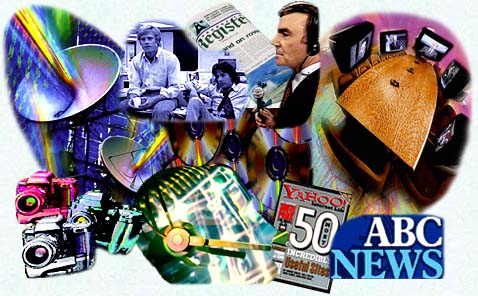 |
News Media - Parts of the mass media that tell the public what is going on in the country and the world. However, the distinction between entertainment and news is blurred. New programs often have entertainment value, and entertainment programs often convey news. The news media is a good source of getting daily information of local, national, and global news. |  Newspapers and news reporters  |
Television –
Changed American politics than any other invention. It cuts across age groups,
education levels, social classes, and races. Furthermore, it has an emotional
impact that print media cannot match. People watch television for both news and entertainment. |  Televisions and its viewing audience  |
Issue Advocacy – Promoting a particular position or an issue by interests groups or individuals but not candidates. (Much issue advocacy is often electioneering for or against a candidate and, until 2004, had not been subject to regulation). An example of issue advocacy are environmentalists who want to advocate greener energy and recycling. | 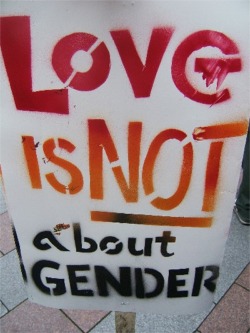 Anti-war and gay rights activists  |
Radio - Radio continues to reach more American households than television does. American get more than the “facts” from radio: they also get analysis and opinion from commentators and talk show hosts. Since radio audiences are distinctive, campaigns can target younger or older voters, women, and so on. People often tune into radios to hear of recent news.
| 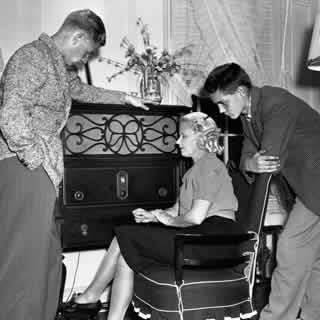 Roosevelt's fireside chats 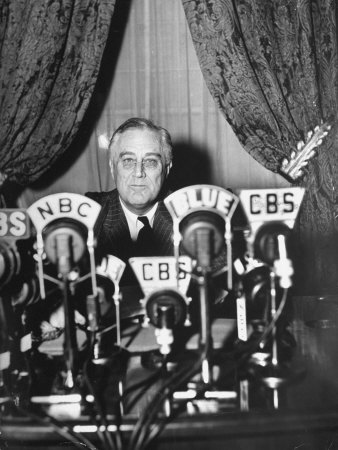 |
Newspapers – Although there is stiff competition from radio and television, American still read their newspapers, but newspaper circulation has been declining for the past 30 years. Readership among the younger persons have declined by almost a third between 1967 and 2005. Newspapers are the traditional means of attaining information. | 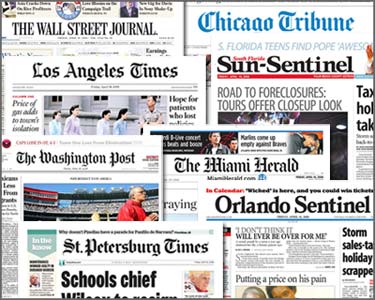 Various Newspapers 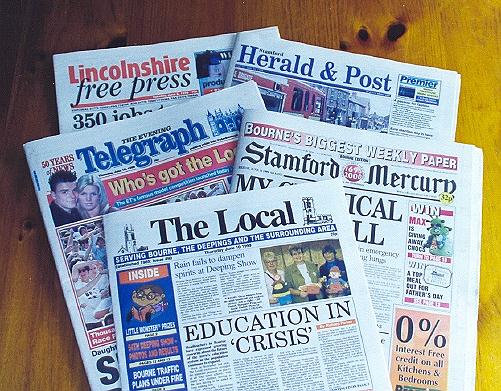 |
Internet – The web provides an inexpensive way to communicate with volunteers, contributors, and voters. Furthermore, the success of the parties and candidates in internet fundraising may significantly change the way politics is financed. The internet makes looking up news, videos, and other things easy. | 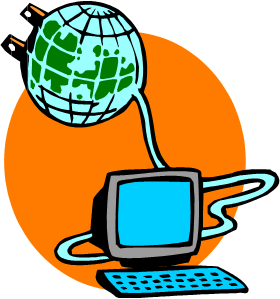 Logo of internet explorer 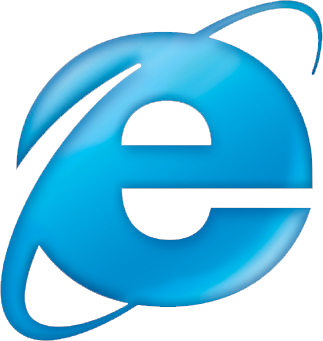 |
World wide web (WWW) – The WWW is now the most popular way of using internet because it transmits pictures, data, and text. The world wide web makes using the internet easier. |  WWW and functions of the WWW 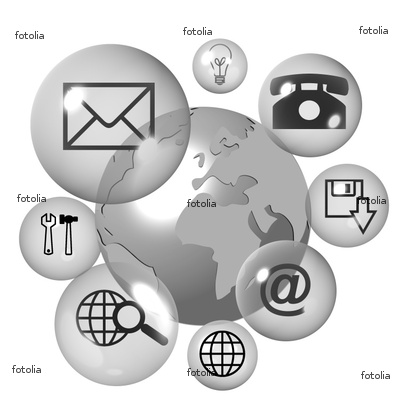 |
Media Bashing – Americans blame the media for everything from increased tension between the races, biased attacks on public officials, sleaze and sensationalism. However, Americans tend to blame far more problems on the media than are warranted. Media bashing is irrational, and blaming the media for the problems of society will not fix anything. |  Cartoon about media  |
Media Conglomerates - Local firms used to own the regional newspapers, radio, and television stations. As in other sectors of the economy, media companies have merged and created large conglomerates of many newspapers and broadcasting stations like FOX network. Media conglomerates, like FOX network, hold many forms of media outlets. |  Various Media conglomerates 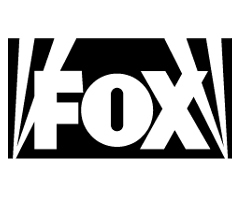 |
Federal Communications Commission (FCC) - An independent regulatory commission charged with licensing stations. The FCC tried to lower the maximum population a conglomerate could reach, but it got struck down later. |  logo and symbol of the FCC  |
Gatekeepers – Independent news providers. When reporting national news, local outlets depend heavily on news that national organizations like the associated press gather, edit, and distribute. As a result, some people contend that information is more diluted, homogenized, and moderated than it would be if the newspapers and broadcast stations were locally owned and the news was gathered and edited locally. Gatekeepers are independent from news conglomerates. |  Various local and independent newspapers 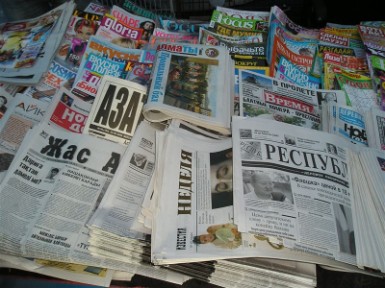 |
Public Opinion– Media’s ability to present images and communicate events has influenced American public opinion. However, people will interpret political messages depending on different factors. Also consultants report the results of public opinion polls, which in turn determine what the new candidate says and does. The public opinion is influenced by media and vice versa. | 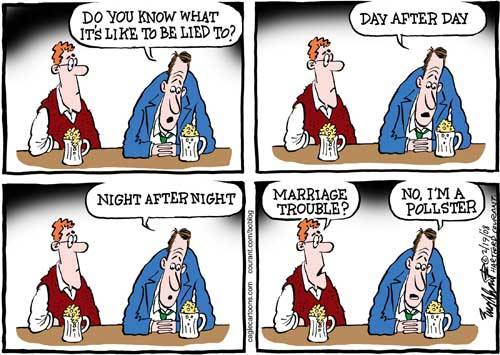 Cartoon about how media affects general population  |
Political socialization – We develop our political attitudes, values, and beliefs through an education process called political socialization. The media are a socializing force and help shape public perceptions and knowledge. Political socialization depends on the media. | 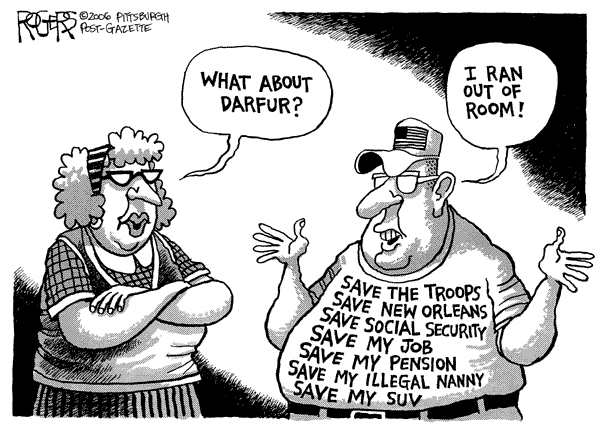 Cartoons about political socialization  |
Selective exposure – The process by which we develop our political attitudes, values, and beliefs. They screen out messages that do not conform to their own biases and they do this by subscribing to newspapers or magazines or turn to television and cable news outlets that support their views. Selective exposure is a very narrow minded way of behaving. |  A filter and a picture of an example of selective exposure  |
Selective perception – The process by which individuals perceive what they want to in media messages. People who use selective perception cannot live up to the reality of things. | 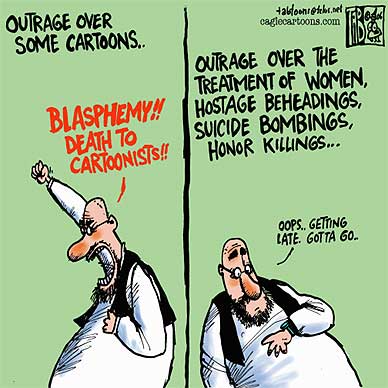 Cartoons of selective perception  |
Sensationalism – One bias of the media that does not have a particular partisan or ideological slant is the bias toward sensationalism. Scandals of all types happen to liberals and conservatives, republicans and democrats. The media have seemed to gravitate to stories involving celebrities, sex, or both. The news these days seem to be full of sensationalism. | 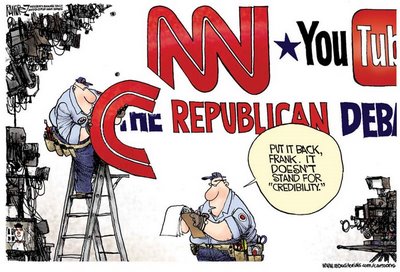 Cartoons about the credibility of news 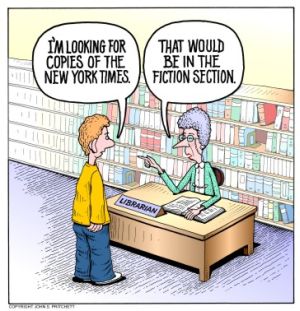 |
Agenda Setting – By calling attention to certain issues, the media help determine what topics will become subjects of public debate and legislation. However, the media do not have absolute power to set the public agenda. The media is powerful and influential because of their ability to sway agenda setting. |  Various agendas 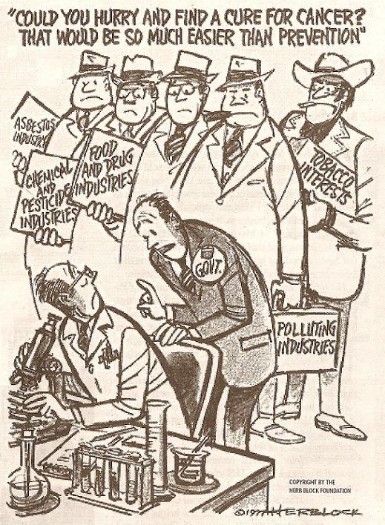 |
Issue Framing – Politicians try to frame issues to win support, and they try to influence the “spin” the media will give to their actions or issues. Politicians try issue framing to make their actions seem better or right. |  Cartoons of issue framing 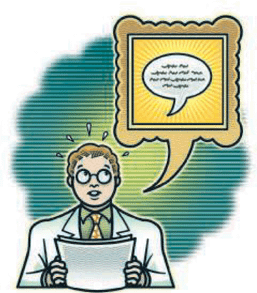 |
Photo Ops – Candidates schedule events in settings that reinforce their verbal messages and public image. However, many campaign events fail to receive attention from reporters because they are edged out by another news stories and a sense that the events were staged to generate news coverage. Photo ops are used to raise a candidates popularity. | 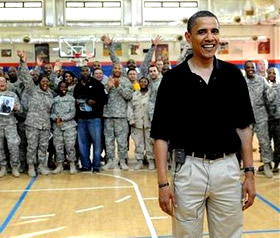 Photo ops of Bush and Obama 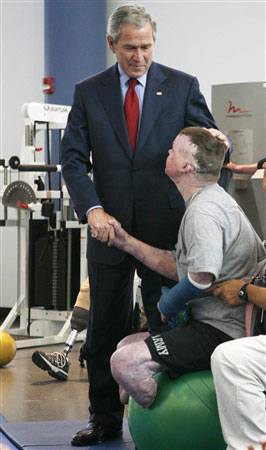 |
Sound bites - A very short piece of a speech taken from a longer speech, considered by those who edit the speech or interview to be the most important point. It gives the audience the main point without confusing them. Sound bites were created for people who want to get the message of the speech right away. | 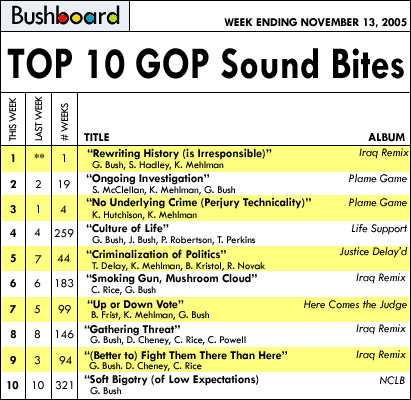 Cartoons of sound bites 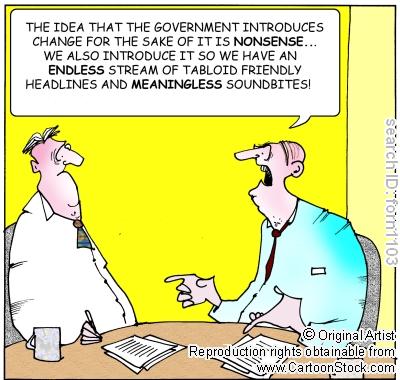 |
Media Consultant – Campaign professionals who provide candidates with advice and services on media relations, advertising strategy, and opinion poling. A primary responsibility of a campaign media consultant is to present a positive image of the candidate and to reinforce negative images of the opponent. The media consultant helped Obama gain popularity. |  Pictures of ways media consultants do their job 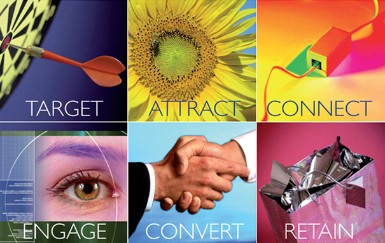 |
Horse Race – A common tendency in the media is to comment less on a candidate’s position on issues than on a candidate’s position in the polls compared with other candidates. Many stores focus on who is ahead, who is behind, who is going to win, and who is going to lose, rather than examining how and why the race is as it is. Media often focuses on the poll standings or Horse Race than on the important issues of the candidates. |  A picture of a literal horse race versus a political race standings  |
Public Policy (How media affects it) When policies are being formulated and implemented, decision makers are their most impressionable, yet the press has little impact at this stage. Lack of press attention to how policies are implemented explains in part why we know less about how government officials go about their business. Only in the case of a policy scandal such as lax security surrounding nuclear secrets at los Alamos, does the press take notice. Some critics contend that the media’s pressuring policy makers to provide immediate answer forces them to make untimely decisions. Media tends to negatively affect public policy. |  Capitol hill and a war room 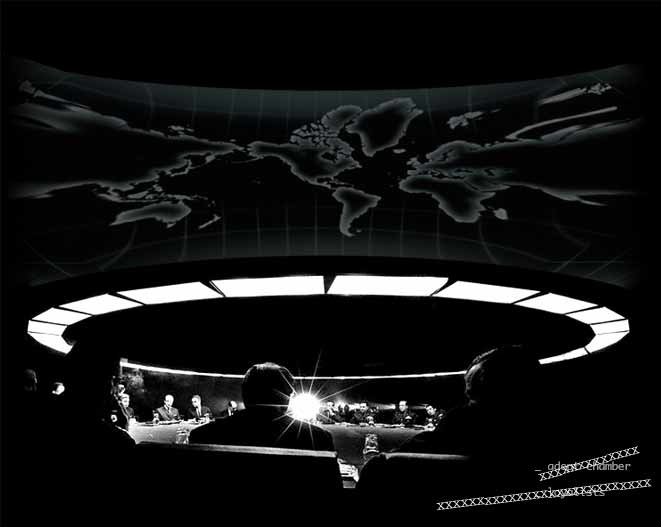 |
REVIEW TIME!! Multiple Choice 1. A common tendency in the media is to comment less on a candidate’s position on issues than on a candidate’s position in the polls compared with other candidates. –horse race A. Public Policy B. Horse Race C. Issue advocacy D.Rat Race 2. The process by which individuals perceive what they want to in media messages. A. Selective Exposure B. Selective Perception C. Public Opinion D.Political Socialization 3. Promoting a particular position or an issue by interests groups or individuals but not candidates. A. Issue Advocacy B. Horse Race C. Agenda Setting D.Public Policy 4. An independent regulatory commission charged with licensing stations. A. Federal Election Commission (FEC) B. World Wide Web (WWW) C. Federal Communications Commision (FCC) D.Bipartisan Communications Reform Act (BCRA) 5. Campaign professionals who provide candidates with advice and services on media relations, advertising strategy, and opinion polling. A. Poll Taker B. Cabinet Member C. Senator D.Media Consultant Fill in the Blank 1. ___________ Disseminates messages to a large and often heterogeneous audience through Newspapers and magazines, radio, television, internet, films, recordings, books, and electronic communication. 2. One bias of the media that does not have a particular partisan or ideological slant is the bias toward ____________________. 3. By calling attention to certain issues, the media help determine what topics will become subjects of public debate and legislation, this is called _____________. 4. Candidates schedule events called ________. These are in settings that reinforce their verbal messages and public image. 5. A ________ is a very short piece of a speech taken from a longer speech, considered by those who edit the speech or interview to be the most important point. ANSWERS Multiple Choice 1. B 2. B 3. A 4. C 5. D Fill in the Blank 1. Mass Media 2. Sensationalism 3. Agenda setting 4. Photo Ops 5. Sound Bite